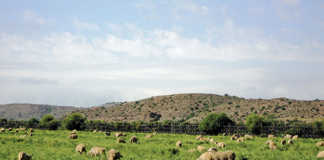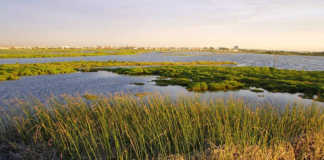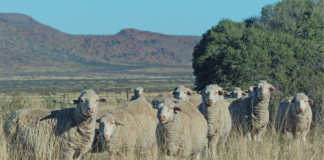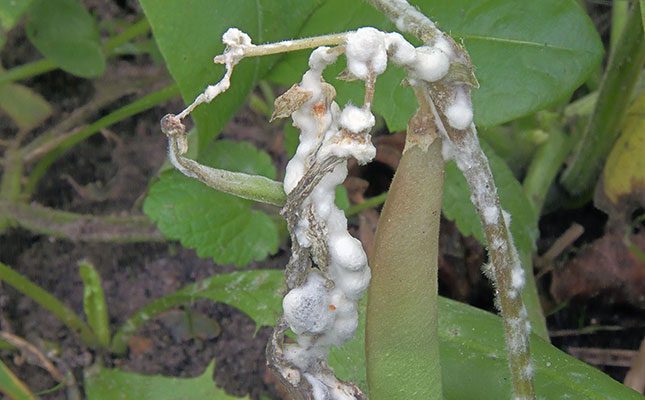
Photo: Wikimedia Commons
As marginal cropping and low-input farming grow, sunflowers are gaining recognition as a suitable crop to cultivate rotationally with maize.
Producers in dryland producing regions find sunflowers appealing due to their general drought tolerance and capacity to provide relatively constant harvests under adverse weather conditions and promising income due to sunflower oil’s application in food preparation, biofuel production, and cosmetics and skin care products.
READ The value of pollinators for seed production
Sunflower flour and cake are fed to animals and the seeds are used for bird seed and human consumption. However, sunflower production is challenged by various insect pests.
The sporadic occurrence of the false chinch bug (Nysius natalensis) and the disease sclerotinia head and/or stalk rot, caused by the fungus Sclerotinia sclerotiorum, plays a role in the decline of sunflower plantings.
In South Africa, the region between 24°S and 30°S is the primary growing region for sunflowers.
Up to 80% of the country’s sunflower production occurs in regions that have a semi-arid environment with variable and infrequent rainfall, low humidity and intense summertime sun radiation.
In the eastern highveld districts of Mpumalanga and the eastern portions of the Free State, the crop is often sown between November and December.
In the western regions of the Free State and North West, planting dates might be extended until mid-January; in the northern portion of the production area, planting takes place in January and February.
The northern region’s late planting date is determined by the area’s late rainfall.
Sunflower planting is frequently delayed past the customary dates by delayed spring rains throughout the whole summer rainfall area.
False chinch bug (vals stink- gogga, Nysius natalensis)
Four species of Nysius are found in South Africa: Nysius binotatus, N. pallidus, N. stali and N. natalensis, also known as the false chinch bug.
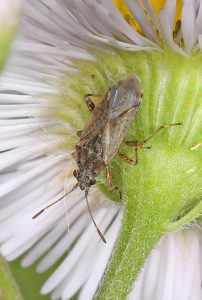
This pest is widespread in South Africa’s sunflower-producing regions.
Favourable environmental circumstances, such as fewer days of frost and a later onset of frost, allow for greater availability of suitable host plants and a longer period for the development of populations.
False chinch bug females lay their eggs on, close to, or between the bract leaves and the seeds.
Eggs can be deposited individually or in groups. Newly hatched nymphs are small and challenging to see with the naked eye.
They go through five nymphal instars (the stage of the insect between successive moults) before emerging as adults.
An adult false chinch bug is identified when wings have developed on the body, are 4mm to 5mm long and have a greyish-brown appearance.
The polyphagous behaviour of N. natalensis, in conjunction with an ideal temperature range for growth within its zone of distribution, plays a significant role in dictating the pest’s population density.
Weedy host plants play a critical role in sustaining false chinch bug populations.
They prefer weedy host plants, but when weeds are absent they rely on alternative host plants such as wheat (Triticum aestivum), onions (Allium cepa), leeks (Allium ampeloprasum), garlic (Allium sativum), alfalfa (Medicago sativa), pistachio nuts (Pistacia vera) and more commonly, sunflowers.
READ How weeds are able to survive
Pigweed (Amaranthus hybridus), tall fleabane (Conyza albida), white goosefoot (Chenopodium album) and common purselane (Portulaca oleracea) are usually abundant in patches of varying sizes within sunflower production areas that constitute one or more species.
All of these weedy hosts’ seeds as well as sunflower seeds are suitable for N. natalensis’s food supply, development and survival. False chinch bugs consistently have sites to oviposit owing to the variety of hosts and the succession of host plant types throughout the season.
Sudden invasion of crops
The occurrence of false chinch bugs is unpredictable and sporadic.
This species’s unpredictable ability to migrate over large distances while using atmospheric disturbances as a means of transportation may account for the unexpected and sudden invasion of sunflower crops in areas where weedy host plants are scarce.
Based on observations, sunflower crops are typically harmed by false chinch bug from March, when headlands or nearby weedy crop fields, which are hosts to the species, are cultivated.
At seed-fill, they transition from weeds during autumn senescence to late-planted sunflower.
During the seedling stage and budding period, large numbers of false chinch bug may invade and feed on the vascular tissues of the young sunflower plants, causing them to wilt and perish.
A field may contain large numbers of this pest buy only a small number of plants experience severe to irreversible damage that lowers seed yield, oil content, and poor germination.
How to manage the pest?
Since sunflower seeds are also suitable for the feeding, development and survival of false chinch bug, management should be focused on maintaining the pest on its wild hosts.
Due to this pest’s polyphagy, or strong appetite, and ability to reproduce successfully on common weed species — which allows it to establish within sunflower farms — cultural control methods might be able to reduce pest populations and crop damage.
Headlands and nearby fields should be kept weed-free from the start of the season to prevent the build-up of pest populations and lower the risk of short-range spread.
Moreover, during the seed-fill stage of sunflower crops, weedy headlands and nearby fields with host plants ought not to be hoed because doing so destroys the host plants, which leads to an invasion of the sunflower fields.
READ How to store seed properly for maximum yield
When planting, try to avoid executing it too late. Farmers should pay close attention to the time at which weeds are managed, because when the preferred host plant, weeds, is eliminated during the management of sunflower fields, it forces the false chinch bugs to move to sunflower heads.
Weed control is necessary to effectively control populations of false chinch bugs, however the time of execution is crucial.
Delaying weed eradication in rows, surrounding fields and neighbouring fields until after sunflowers have surpassed their most vulnerable stages (seedling and budding period) will help limit the movement of false chinch bugs from their preferred host plants to sunflowers.
Sclerotinia head and stalk rot
Sclerotinia sclerotiorum is a damaging fungal pathogen that has an extensive host range, which possibly exceeds over 500 plant species.
These include crops such as soya bean (Glycine max), beans (Phaseolus vulgaris), canola (Brassica napus), lupines (Lupinus perennis), a variety of vegetable crops as well as many weed species, which may all serve as alternate hosts for the pathogen. On sunflowers, it also results in sclerotinia head and/or stalk rot.
Because only individual plants in a field may become infected, sclerotinia stalk rot of sunflower is not a direct substantial danger to sunflower production in South Africa.
Sclerotinia head rot, however, can result in significant harm, especially to crops that are sown early and ripen in cool, moist circumstances.
In addition to the main producing regions for sunflowers (Limpopo, North West, Mpumalanga and Free State), other provinces that grow sunflower may also experience sclerotinia head rot.
It is concerning because the disease affecting sunflowers continues to spread toward the western regions that produce maize.
The two most significant rotation crops (sunflower and soya bean) in this maize-producing region may no longer be economically viable to sow due to elevated inoculum levels.
This implies that it is difficult or nearly impossible to eradicate the disease after it has spread throughout a region or field.
It is one of the main causes of sunflowers’ decline as a maize alternative in some regions, like Mpumalanga.
Although seasonal variation is typical, it cannot be believed that a location with a history of sclerotinia head rot is disease-free if the disease does not appear there during a particular season.
Since S. sclerotiorum sclerotia have been known to survive up to seven years in the soil, there may be an inoculum waiting for the right circumstances to allow for infection. If favourable conditions hold, the disease can resurface in the next season.
How does Sclerotinia infect sunflower plants?
- Sclerotinia head rot
In the field, the fungus exists as sclerotia in the debris of plants. In the soil, sclerotia can live for up to seven years. Infection happens when there are significant amounts of rainfall and low temperature during the flowering period.
When sclerotia germinate in moist soil, they produce apothecia, which are tiny fruiting structures that resemble mushrooms. In moist weather, apothecia grow and release windborne spores that can infect the sunflower head.
Head rot may start from wounds on the back of the sunflower heads, which could become sites of infection.
- Sclerotinia stalk rot
Sclerotia germinate and infect sunflower roots when they come into contact with them during the summer. From the contaminated root, the fungus spreads to the taproot, where it produces a canker at the base of the stem.
The plant eventually wilts and dies because this infection stops it from absorbing water and nutrients. Root-to-root contact between sick plants can spread the infection to nearby plants. The weather conditions have little or no impact on the development of stalk rot.
How to identify the Sclerotinia diseases
- Sclerotinia head rot
As the fungus releases spores during flowering, it infects the back of the head. When the conditions are favourable, the infection worsens and the tissues become spongy, light brown, and soft.
Eventually, only the fibrous strands at the back of the head and upper stalk remain due to this infection, which also spreads into the developing head and down the stalk.
Soon enough, the weight of the infected seed at the front of the head causes it to fall out of the head. Below the seed layer and surrounding the seeds, large black sclerotia (small, black particles that resemble bird droppings) form.
- Sclerotinia stalk rot
The infected plant will first exhibit abrupt wilting, especially during grain fill, and a light brown, wet spot at the base of the stalk will become noticeable. The tissue of the sunflower stem pith is white and resembles cotton.
It contains a mycelial growth where large black sclerotia develop. As sunflower plants age, sclerotia may occasionally be noticed on the outside of the stalks.
At this stage of infection, the stalk frequently breaks, revealing black sclerotia when it is torn open. Since the plant is not absorbing enough water and nutrients, heads do not fill correctly.
How to manage the disease
Sunflower head rot outbreaks have the potential to infest areas that were previously sclerotinia-free or had low sclerotinia levels.
Sunflowers and other sensitive crops, which might be replanted after a season of maize, are at risk from the diseased fields since sclerotia can persist for extended periods of time in infected soil.
Sunflowers should not be planted on contaminated land for a minimum of five to eight years, according to recommended practice. This can mean growing maize in a monoculture for at least five growing seasons, depending on the production conditions in the area.
Read Preventing and controlling diseases of sunflowers
More so than head rot, rotation will lessen stem rot. Spores carried by the wind and carried in from the surroundings can still cause head rot. Sclerotia that are buried deeply are unable to produce apothecia.
It is imperative to refrain from exposing these subterranean sclerotia in subsequent seasons, since this may lead to the resurgence of the disease.
Sunflowers may be threatened by these pests and fungi, but farmers can act preventatively by implementing management strategies to lessen the pressure of both.
Sunflower producers can achieve more ecologically friendly and sustainable pest and disease control, improving crop yields and product quality while lowering long-term dependency on chemical pesticides, by incorporating integrated pest management into their operations.
This strategy not only improves financial performance but also fosters ecosystem health and the welfare of both farmers and consumers.
Adopting integrated pest management is a critical step toward ensuring sunflower agriculture’s sustained success in the face of evolving pest and disease challenges.
Email Zunel van Eeden at [email protected]









